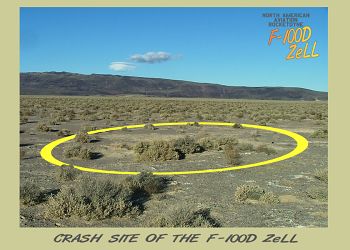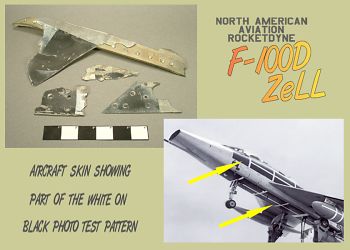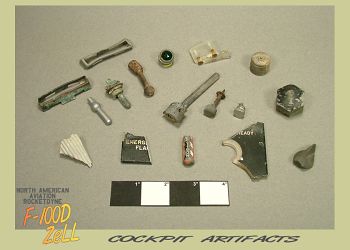
 |
The video contained footage of Blackburn's bailout and a few quick glimpses of the wrecked F-100. There were three views of the impact site. The first showed an overhead view of the wreckage and the surrounding area. In a second shot, firemen were spraying the burning debris with foam, and finally, there was a shot of the investigators examining the wreckage, including the crushed rocket booster.
The airplane's fuselage had been burned by the post-impact fire, but the wings and tail surfaces were intact. Pete and Tony expected the debris would be concentrated in an area about the size of the airplane itself. To gather more information, Pete corresponded with Al Blackburn and tracked down press accounts. The F-100 had crashed about a mile north of Harper Dry Lake, about 30 miles northeast of Edwards AFB.
Harper Dry Lake is about six miles long and three miles wide, and is shaped like an elongated letter U with the long axis running east to west. At about its midpoint, the lakebed is bisected by a dirt road running north and south. Beside the road is a barbed-wire fence. The area to the north of the lakebed is a gentle alluvial slope consisting of sand and small rocks washed down from the surrounding hills. The vegetation is scattered brush. There is a set of flood control channels to the west of the fence, and at the far southwestern corner of the lakebed is a solar power generating station.
 |
They returned to Harper Lake with Curtis Peebles on 22 February. This time they had several still frames from the video to serve as a guide. It was apparent that the picture of the engineers was taken looking almost due east. There were two sets of mountains, and the task became a matter of finding a position such that the near and far mountains lined up correctly relative to each other. The photo seemed to show a rolling landscape, with the impact point in a low area, and a rise in the background. The other two photos were more ambiguous. The shot of the firemen seemed to have been taken looking almost due south, towards several low hills on the horizon.
There was no clear view of the lakebed, but rather two long tan areas against darker areas of brush. This seemed to indicate the impact point was away from the lakebed. The overhead shot of the wreckage, however, showed an area almost bare of foliage, with a light tan surface and only a scattering of darker rocks. This indicated a site on the edge of the lakebed. The still photos were fuzzy and included the pattern of the television screen.
 |
Having again failed to find the NF-100D, the search adjourned for the summer months, and it was not until 8 November 1997 that they returned to try again. This time they explored a part of the lakebed farther to the east and closer to the lakebed. The results were disappointing.
At dusk they gave up and headed back to Lancaster. While driving through the sparse Joshua Tree forest east of Rogers Dry Lake, They noticed a pillar of fire rising in the west. It was a Delta II rocket from Vandenberg Air Force Base, carrying a payload of Iridium communications satellites into orbit. It provided a spectacular display in the evening sky.
Another search attempt on 27 June also resulted in failure. Temperatures exceeded 100 degrees Fahrenheit. The sun was like a burning hammer pounding the searchers into the anvil of the claypan. Curtis described the adventure as the "Harper Lake Death March." They turned back at the fence line. It was just too hot to go on.
On 4 October 1998 Pete, Tony, and Curtis returned to Harper Lake with Tom Tschida, and Dallas Morning News staff writer J. Lynn Lunsford. Tom had produced better copies of the video still frames that still served as the best clue for locating the crash site.
 |
Over the course of the next four hours, they found a Winnie-the-Pooh balloon, three instrument packages from weather balloons, a tow target dating from World War II, and numerous .50 caliber machine gun shell casings. They also stumbled across a sidewinder rattlesnake about eight inches long, reddish tan with brown stripes and a bad temper.
For the first time they crossed the fence line and moved onto the eastern portion of the lakebed. They continued east, then turned south towards the lakebed, then back west and returned to the fence. While Tony and Curtis studied the photos, the reporter discovered that his expensive, rechargeable camera battery had fallen out so he turned back to look for it.
At one point, Tony looked at Lynn, still searching for his lost battery, and said: "Wouldn't it be funny if he found it?" A minute or two later, Lynn began waving his arms, and yelling that he had found a piece of metal.
The aluminum fragment was the size of a thumbnail. One side was shiny, but the other had traces of green paint of the type of paint used in 1950s aircraft interiors. A search of the surrounding area yielded more pieces and, finally, the main impact point. They had found the site at last!
As expected, the debris field was not much wider than the airplane. The wreckage included aluminum skin and structure, electronics, engine parts and cockpit debris.
Among the engine parts was a burned Pratt & Whitney placard. A small access panel from one of the wing pylons had a date of manufacture, North American Aviation inspection stamp and was stenciled with the words PYLON EJECTION BREACH ACCESS. Many of the pieces, including the inspection port cover, had F-100D part numbers. They also found several pieces of the plane's skin that were covered with black paint and narrow white stripes. This pattern was unique to the first ZeLL NF-100D. It covered the plane's underside, and the left side of the fuselage and the vertical tail. There was no question about the identity of the crash site.
|
|
